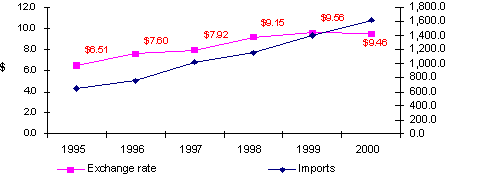


Cámara Nacional de las Industrias de la Celulosa y el Papel
Mexico's macroeconomic performance in 2000 was favourable in many respects: growth in GDP of 6.9 percent, downward inflation to 8.9 percent; unemployment at 2.0 percent; international reserves of US$32.7 billion; and a very stable rate of exchange throughout the year, closing at 9.70 pesos to the dollar.
On the political level, the democratic transition took place peacefully, so Mexico had a good year in general terms, as a country, but the pulp and paper industry faced a number of problems that limited growth, as detailed below.
Macroeconomic results
Variables |
1999 |
20001 |
GDP |
3.7% |
6.9% |
Inflation |
12.3% |
8.9% |
Financial surplus or deficit (proportion of GDP) |
-1.1% |
-0.8% |
Monetary reserves* |
30 734 |
32 700 |
Current account |
-2.9% |
-3.0% |
Trade balance* |
-5 584 |
-8 049 |
1 Estimated figures
* million US$
Reserves at the end of December
The United States economy began to show clear signs of deceleration towards the end of last year, producing a surplus of paper supply, which in turn had a negative impact on Mexico's national industry because of the lower international prices of paper. This excess supply combined with an overvalued rate of exchange against the dollar resulted in a 15.8 percent growth in imports, far above the growth in national production of 2.7 percent.
Against such a scenario, the most relevant data for Mexico's pulp and paper industry are given below.
Pulp production in the year 2000
Type of pulp |
1999 |
2000 |
Var. % 00/99 |
(thousand tonnes) | |||
Bleached long fibre |
96.5 |
100.7 |
4.4 |
Short fibre |
120.7 |
127.6 |
5.7 |
Unbleached long fibre |
83.6 |
71.2 |
-14.8 |
Bagasse |
194.7 |
199.8 |
2.6 |
Thermo-mechanical |
22.3 |
36.1 |
61.9 |
Chemical thermo-mechanical |
26.3 |
46.7 |
77.6 |
Total |
544.1 |
582.1 |
7.0 |
Consumption of fibres in 2000
Type |
% of total 1999 |
% of total 2000 |
|
Domestic virgin fibres Imported virgin fibres Total virgin fibres |
12.6 7.6 20.2 |
13.1 6.6 19.7 |
|
Domestic secondary fibres Imported secondary fibres Total secondary fibres |
51.1 28.7 79.8 |
52.9 27.4 80.3 |
Total |
100.0 |
100.0 |
Paper production in 2000
1999 |
2000 |
Var. % 00/99 |
|
(thousand tonnes) |
|||
Newsprint |
247.1 |
254.8 |
3.1 |
Writing and printing |
698.3 |
688.3 |
-1.4 |
Paper for sacks, bags and wrapping |
237.4 |
230.4 |
-2.9 |
Containerboard |
1 585.2 |
1 649.3 |
4.0 |
Folding boxboard |
345.0 |
355.6 |
3.1 |
Sanitary and facial |
661.5 |
691.2 |
4.5 |
Specialty |
21.5 |
27.4 |
27.4 |
Total |
3 796.0 |
3 897.0 |
2.7 |
It can be noted that newsprint increased by barely 3.1 percent; writing and printing paper fell 1.4 percent; paper for sacks, bags and wrapping also fell, by 2.9 percent; paper for containerboard, comprising linerboard and corrugated medium, rose by 4.0 percent; folding boxboard rose by 3.1 percent; production of sanitary and facial tissues increased 4.5 percent and specialty papers rose by 27.4 percent, but this line of products only involves small volumes and therefore a very marginal proportion of production.
Overall, paper production in 2000 rose 2.7 percent against 1999, totalling 3 897 000 tonnes, which is in marked contrast to the concurrent growth in imports of 15.8 percent.
Imports and exports were as follows:
Total imports in 2000
1999 |
2000 |
Var. % 00/99 | |
(thousand tonnes) | |||
Newsprint |
172.2 |
11175.4 |
1.9 |
Writing and printing |
297.2 |
356.2 |
19.9 |
Paper for sacks, bags and wrapping |
49.6 |
62.4 |
25.8 |
Containerboard |
421.2 |
497.3 |
18.1 |
Folding boxboard |
57.9 |
59.5 |
2.8 |
Bleached kraft boxboard |
98.0 |
97.7 |
-0.3 |
Sanitary and facial |
48.5 |
67.2 |
38.6 |
Specialty |
253.0 |
303.3 |
19.9 |
Total |
1 397.6 |
1 619.0 |
15.8 |
Exports in 2000
1999 |
2000 |
Var. % 00/99 | |
(thousand tonnes) | |||
Newsprint |
30.3 |
25.8 |
-14.9 |
Writing and printing |
24.7 |
17.6 |
-28.7 |
Paper for sacks, bags and wrapping |
7.1 |
2.9 |
-59.2 |
Containerboard |
40.1 |
23.8 |
-40.6 |
Folding boxboard |
35.6 |
34.3 |
-3.7 |
Sanitary and facial |
90.2 |
98.8 |
9.5 |
Specialty |
2.4 |
2.4 |
0.0 |
Total |
230.4 |
205.6 |
-10.8 |
Apparent consumption of paper in Mexico rose by 7.0 percent, driven mainly by imports, with domestic production in difficulty and posting an increase of barely 2.7 percent.
There is no doubt that imports have been heavily influenced by the exchange rate and will continue to rise so long as the peso is undervalued, as can be seen from the following graph.
Impact of exchange rate on paper imports
1995-2000

The new Administration of the Federal Executive envisages extensive budgetary reform, which would not only provide more resources to public finances but would also temper the impact of the financial cost of the government by reducing the need for domestic and external funding. This would also free sizeable banking resources which are presently mostly earmarked for the State, these being used instead as investment and housing loans, with an accompanying substantial reduction in bank rates.
Some of the fundamental objectives of budgetary reform are also to generate better distribution of income, broaden the tax base and simplify fiscal systems and procedures.